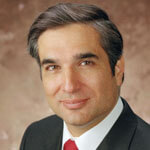
Francisco G. Cigarroa, M.D., president of the Health Science Center, was one of the speakers July 11 as San Antonio hosted a public hearing of the Base Realignment and Closure Commission (BRAC).
Dr. Cigarroa, a member of the San Antonio Area Military Missions Task Force, voiced support for the U.S. Department of Defense’s recommendations for military medicine affecting San Antonio. Those recommendations include making Fort Sam Houston a Defense Department Center for Joint Enlisted Training. The post would become a center for medical training of enlisted personnel and gain more than 9,300 jobs.
“Great centers of military medicine – and academic medicine – require a synergy of education, research and clinical care,” Dr. Cigarroa said, referring to the existing high degree of collaboration between the Health Science Center and its military partners in San Antonio. “This is what we proudly offer, and we pledge to be a national treasure for our military and their families.”
He said the recommendations to build a regional medical center at Brooke Army Medical Center on Fort Sam Houston, consolidate medical training and establish a Joint Center of Excellence in Battlefield Health and Trauma are compatible with the expertise in San Antonio.
“With Brooke Army Medical Center, the Air Force’s Wilford Hall Medical Center and the South Texas Veterans Health Care System, San Antonio has long been the place to which the nation has brought its wounded and cared for the nation’s heroes – from private to President,” Dr. Cigarroa said.
Overall, San Antonio would gain 3,500 jobs and $1 billion in construction. Although the city would lose one of its Level I trauma centers, Wilford Hall, which would be converted into a clinic, the newer Brooke Army would shoulder Wilford Hall’s share of the region’s trauma care. University Hospital, one of the Health Science Center’s primary teaching hospitals, is the civilian Level I trauma center.
“We are confident that we can adjust to two Level I Trauma Centers,” Dr. Cigarroa said. “The loss of Wilford Hall’s inpatient services, however, will require investment at both the new military medical center and the University Health System. We would appreciate the BRAC revalidating this commitment to keeping the total volume of military trauma care at current levels.”
He said the Department of Defense’s recommendations for military medicine in San Antonio are “far-reaching and visionary. They make logical sense. They build upon what is already happening. You should not change them.”
Dr. Cigarroa concluded by pointing out many examples of the Health Science Center’s unique collaboration with the military. “On any given day, dozens of Health Science Center students, residents and faculty are engaged in clinical care, education and research at the military hospitals,” he said. “And in turn, the Health Science Center has dozens of military physicians, nurses and others engaged in education and research in our programs. The leaders of San Antonio would appreciate the BRAC acknowledging the Health Science Center’s special relationship as the preferred partner for the military medical organizations in education, research and clinical care, and adding value to military medicine unlike any place in the country.”

